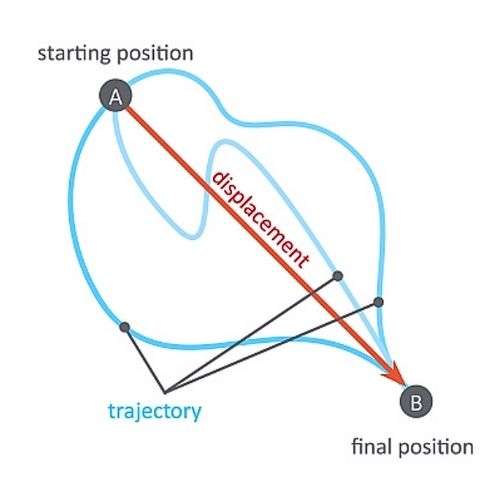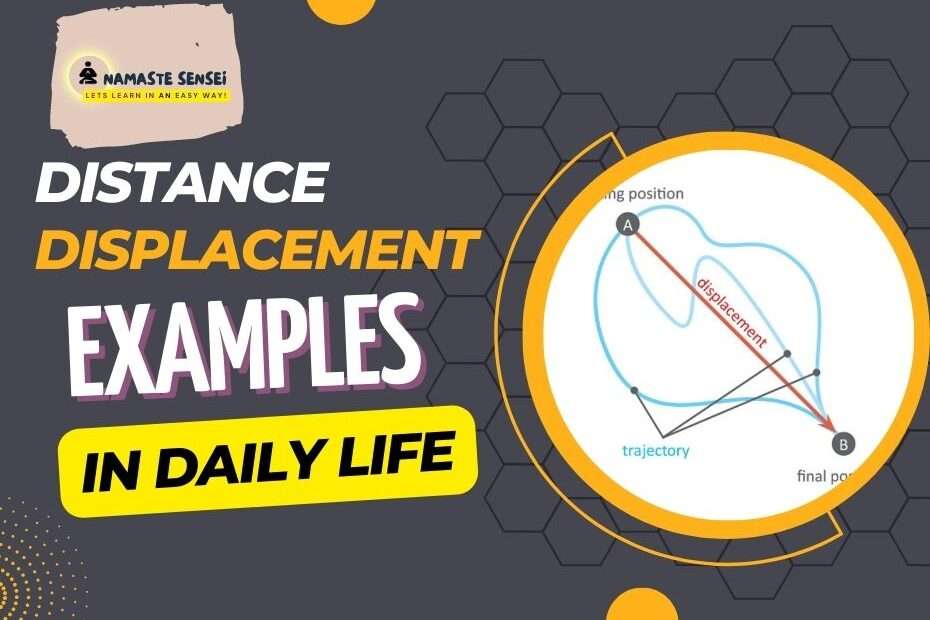Examples of Distance And Displacement In Daily Life

Examples of Distance And Displacement
Distance and displacement are two key concepts in physics that we encounter in our everyday lives. Both measure the amount of space between two points, but in different ways. Distance is the total length of the path between two points, while displacement is the total change in position.
In this blog post, we will be looking at 10 examples of distance and displacement in daily life. From walking to the store to driving around town, we will explore how these two concepts are used in our daily activities.
Now, Before you read any further related to distance and displacement examples, it might be a good idea to understand distance and displacement in brief. It will help you to understand examples better. If you want to skip, you can skip by clicking on the link below.
Distance and displacement in brief
- Distance is the path length that an object or person covers while moving from one point to another. In everyday life, examples of distance include how far you walk to get to the store, the length of the pool you swim in, or the distance a ball travels when you throw it.
- Displacement, on the other hand, is the shortest distance between the starting and ending points of an object or person’s movement. In other words, it is the straight-line distance between the starting and ending points. Displacement can be different from a distance if the movement involves changing direction or following a curved path.
Note: If the starting and ending points are the same, regardless of how far the object travels in between, the displacement is zero. In other words, displacement depends only on the starting and ending points, and not on the path taken between them.
For example, if you walk from your house to the store and then back home, the distance you cover would be twice the distance between your house and the store. However, your displacement would be zero because you ended up back where you started.
10 Examples of Distance And Displacement In Daily Life
I hope you understood the concept of distance and displacement given above. Now let’s look at the daily life examples of distance and displacement to understand them more clearly.
- Getting out of bed.
- Walking to the store.
- Moving Furniture
- Driving a car.
- Taking the bus.
- Riding a bike.
- Flying in an airplane.
- Swimming.
- Running.
- Throwing a ball.
Examples
-
Getting out of bed: The distance covered would depend on how far you have to walk to get out of your bedroom.
For example, if you have to walk 10 feet to get to the bathroom, the distance covered would be 10 feet. However, the displacement would be the straight-line distance between your starting point (in bed) and your ending point (where you end up after getting out of bed), regardless of how you got there.
So, if you get out of bed and walk directly to the bathroom, the displacement would be the distance between your bed and the bathroom. But if you get out of bed and walk around your room before heading to the bathroom, the displacement would still be the distance between your bed and the bathroom. -
Walking to the store:

The distance covered would be the length of the path you take from your starting point (e.g. your home) to the store and back.
For example, if you walk 2 miles to get to the store and then 2 miles back, the distance covered would be 4 miles.
However, the displacement would be zero if you end up back at your starting point (e.g. if you walked from home to the store and then back home).
-
Moving furniture: The distance covered would depend on how far you move each piece of furniture.
For example, if you move a couch from one end of the room to the other, the distance covered would be the length of the room.
However, the displacement would be the straight-line distance between the starting and ending positions of the furniture. -
Driving a car: The distance covered would be the length of the path you take to get from your starting point to your destination.
For example, if you drive 50 miles from your home to a friend’s house, the distance covered would be 50 miles. But, the displacement would be the straight-line distance between your starting point and your destination. -
Taking the bus: The distance covered would be the length of the path the bus takes from the starting point to the destination.
For example, if you take a bus from your home to the airport, the distance covered would be the length of the bus route. However, the displacement would be the straight-line distance between your starting point and your destination. -
Riding a bike:

The distance covered would be the length of the path you take while riding your bike.
For example, if you ride your bike for 10 miles along a bike path, the distance covered would be 10 miles. However, the displacement would be zero if you end up back at your starting point, or the straight-line distance between your starting and ending positions if you end up at a different point. -
Flying in an airplane: The distance covered would be the length of the flight path from the starting point to the destination.
For example, if you fly from New York to Los Angeles, the distance covered would be the length of the flight path. However, the displacement would be the straight-line distance between your starting point (New York) and your destination (Los Angeles). -
Swimming: The distance covered would be the length of the pool or body of water that you swim in.
For example, if you swim 20 laps in a pool that is 25 meters long, the distance covered would be 500 meters (20 laps x 25 meters per lap). However, the displacement would be zero if you end up back at your starting point, or the straight-line distance between your starting and ending positions if you swim in a straight line. -
Running:

The distance covered would be the length of the path that you run along.
For example, if you run 5 miles along a trail, the distance covered would be 5 miles. However, the displacement would be zero if you end up back at your starting point, or the straight-line distance between your starting and ending positions if you run in a straight line. -
Throwing a ball: The distance covered would be the length of the path that the ball travels.
For example, if you throw a ball 50 feet, the distance would be 50 feet. However, the displacement would be the straight-line distance between your starting position (where you threw the ball) and the ending position (where the ball lands).
I hope that these daily life examples of distance and displacement helped you with a better understanding of the concept.
If there are any further questions or uncertainties regarding the information provided, we are always available to clarify and answer any queries.
References:
-
Textbook: “Physics for Scientists and Engineers” by Giancoli: This is a widely used textbook that covers the fundamentals of physics, including displacement, clearly and concisely.
-
Free Online Resource: Advance Level “MIT OpenCourseWare: Displacement Vector In 3D”: This is a website that provides free access to materials from MIT courses, including physics courses that cover displacement and related concepts.
You have finished the complete article. If you have any doubts or queries, feel free to comment below. We will respond as soon as possible.
Or Email Us At [email protected]
More Articles:
Any topic you want us to cover? Let us know.
